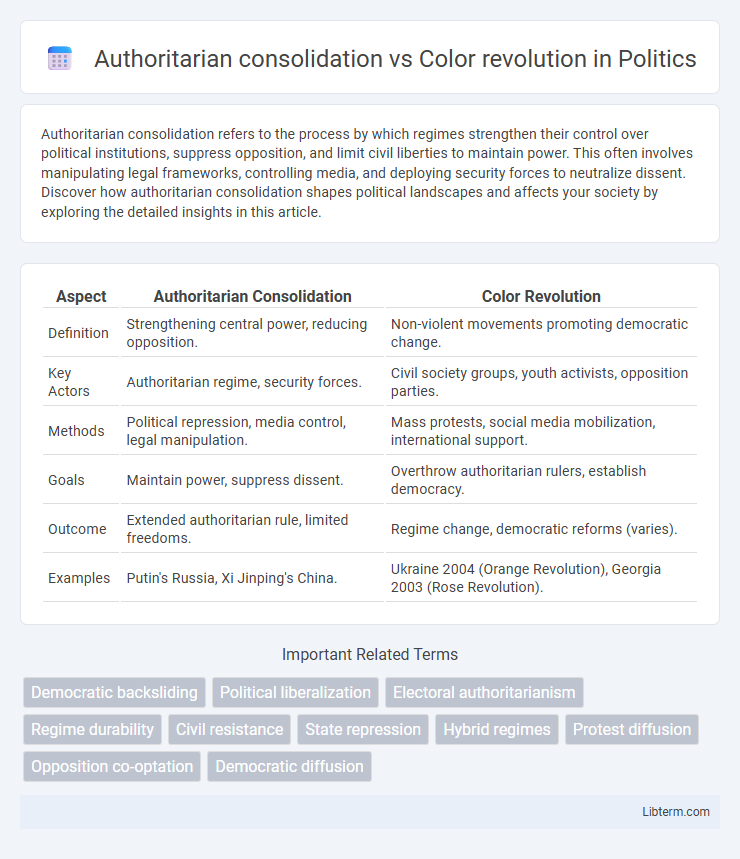Authoritarian consolidation refers to the process by which regimes strengthen their control over political institutions, suppress opposition, and limit civil liberties to maintain power. This often involves manipulating legal frameworks, controlling media, and deploying security forces to neutralize dissent. Discover how authoritarian consolidation shapes political landscapes and affects your society by exploring the detailed insights in this article.
Table of Comparison
| Aspect | Authoritarian Consolidation | Color Revolution |
|---|---|---|
| Definition | Strengthening central power, reducing opposition. | Non-violent movements promoting democratic change. |
| Key Actors | Authoritarian regime, security forces. | Civil society groups, youth activists, opposition parties. |
| Methods | Political repression, media control, legal manipulation. | Mass protests, social media mobilization, international support. |
| Goals | Maintain power, suppress dissent. | Overthrow authoritarian rulers, establish democracy. |
| Outcome | Extended authoritarian rule, limited freedoms. | Regime change, democratic reforms (varies). |
| Examples | Putin's Russia, Xi Jinping's China. | Ukraine 2004 (Orange Revolution), Georgia 2003 (Rose Revolution). |
Understanding Authoritarian Consolidation: Key Features
Authoritarian consolidation involves centralizing power through legal and extralegal means, controlling media, and weakening opposition institutions. Key features include the suppression of dissent, manipulation of electoral processes, and the use of state resources to maintain regime stability. This process contrasts with color revolutions, which are grassroots movements aiming to challenge entrenched authoritarian regimes through nonviolent protests and civil resistance.
The Rise and Dynamics of Color Revolutions
Color revolutions represent popular movements driven by mass mobilization, social media, and demands for democratic reforms, often emerging in authoritarian regimes with weak institutional checks. The rise of color revolutions, exemplified by Ukraine's Orange Revolution and Georgia's Rose Revolution, illustrates how coordinated civic activism and external support challenge authoritarian consolidation through nonviolent resistance. These dynamics force authoritarian governments to adopt repressive measures, manipulate electoral processes, or implement limited reforms to maintain control amid growing domestic and international pressures.
Drivers Behind Authoritarian Persistence
Authoritarian consolidation is driven by strategic control over military, media, and electoral institutions, enabling regimes to maintain power despite social unrest and external pressures. The persistence of authoritarianism often stems from elite cohesion, surveillance technologies, and repression mechanisms that suppress dissent and prevent mobilization typical of color revolutions. Economic resources and international alliances further reinforce regime durability by mitigating vulnerabilities that could otherwise trigger rapid political transitions.
Societal Triggers of Color Revolutions
Color revolutions often emerge from widespread societal triggers such as systemic corruption, economic inequality, and lack of political freedoms, which fuel public discontent and mobilize mass protests. Authoritarian consolidation aims to preempt these triggers by reinforcing state control through media censorship, suppression of dissent, and manipulation of electoral processes. The dynamic interplay between societal grievances and government actions determines the likelihood of successful color revolutions challenging entrenched authoritarian regimes.
Media Control vs Information Flow
Authoritarian consolidation relies heavily on stringent media control, employing state-owned outlets and censorship to restrict information flow and suppress dissent. In contrast, color revolutions leverage free and independent media along with social networks to enhance transparency and mobilize public opinion against authoritarian regimes. The battle between controlled media environments and open information ecosystems shapes the success or failure of political transitions worldwide.
Political Institutions: Stability and Vulnerability
Authoritarian consolidation strengthens centralized political institutions by limiting opposition and controlling electoral processes, enhancing regime stability through administrative and coercive measures. In contrast, color revolutions exploit institutional vulnerabilities such as weak rule of law, ineffective checks and balances, and pervasive corruption to mobilize mass protests and demand democratic reforms. The contrasting dynamics highlight how resilient political institutions either fortify authoritarian regimes or become focal points for revolutionary challenges aiming to dismantle entrenched power structures.
External Influences: International Actors and Agendas
Authoritarian consolidation often relies on strategic alliances with powerful international actors such as Russia and China, which provide economic aid, military support, and diplomatic backing to stabilize regimes and counter Western influence. Color revolutions, typically supported by Western countries and international NGOs, use funding, media, and diplomatic pressure to promote democratic reforms and challenge authoritarian governments. These external influences shape local political dynamics by either reinforcing regime stability or empowering opposition movements through targeted agendas aligned with broader geopolitical interests.
Social Movements and Grassroots Mobilization
Authoritarian consolidation typically involves the suppression of dissent and the co-optation of social movements to maintain centralized control and limit grassroots mobilization. In contrast, color revolutions harness decentralized grassroots activism and social networks to challenge authoritarian regimes, emphasizing nonviolent protest and mass participation. The dynamic interplay between state repression and adaptive mobilization strategies shapes the effectiveness of social movements in either reinforcing authoritarian consolidation or driving political transformation.
Outcomes: Regime Survival vs Democratic Transition
Authoritarian consolidation typically results in regime survival by employing state control, surveillance, and repression to suppress dissent and maintain power. In contrast, color revolutions often lead to democratic transitions by mobilizing popular uprisings, leveraging nonviolent protests, and promoting political reforms that challenge authoritarian regimes. The outcomes differ fundamentally, with authoritarian consolidation reinforcing entrenched power structures and color revolutions fostering political liberalization and increased democratic governance.
Lessons and Future Prospects for Political Change
Authoritarian consolidation leverages centralized control, surveillance, and suppression of dissent to maintain power, often resulting in political stability but limited democratic freedoms. Color revolutions exemplify grassroots mobilization, social media activism, and international support to challenge authoritarian regimes, demonstrating the potential for rapid political change but also vulnerability to crackdown and co-optation. Future prospects for political change depend on the interplay between regime resilience mechanisms and the capacity of civil society to innovate protest strategies amidst evolving digital and geopolitical landscapes.
Authoritarian consolidation Infographic

 libterm.com
libterm.com